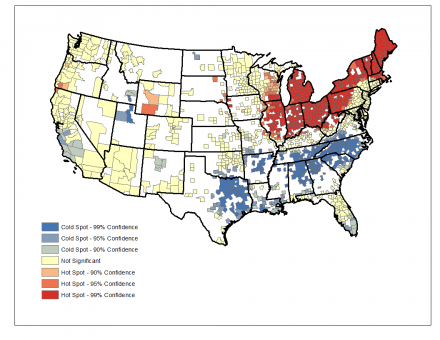U of M Faculty Identifies Clustering of Esophageal Cancer Mortality in the Great Lakes States and New England
Media contact: Lauren Love, 734-647-9512 ; | Patients may contact Cancer AnswerLine™, 800-865-1125
Joel Howard Rubenstein to Present Abstract at Digestive Diseases Week Meeting
Esophageal cancer is the sixth most common cause of cancer deaths worldwide. Despite the rates of some cancers falling over the past 25 years, the frequency of some esophageal cancers is growing and physicians are unable to explain why.

"The incidence of esophageal adenocarcinoma have risen five-fold in the last three decades in the United States," said Joel Howard Rubenstein, MD. "It's becoming more common and we don't know why."
Rubenstein is an associate professor in the Division of Gastroenterology at the University of Michigan, and is a research scientist at the Veterans Affairs Center of Excellence for Clinical Management Research.
In a recent study, Rubenstein examined fatal cases of esophageal cancer in the United States, using data spanning from 1999 to 2014. He sought to determine if there was geographical clustering of esophageal cancer, and if so, was it explained by the known risk factors. What he found sparked even more questions.
"We found clusters of high and low mortality rates with esophageal cancer among white non-Hispanic men in the U.S. that could not be explained by the known common risk factors: age, obesity, smoking and alcohol consumption," he said.
To identify the clustering, Rubenstein looked at county death certificates in counties across the country. To get the most accurate representation, Rubenstein narrowed his scope to only include white, non-Hispanic men and limited his analysis to counties with at least 20 deaths associated with esophageal cancer over the 15-year period.
With data missing predominantly from the central U.S., Rubenstein's cluster analysis showed an area of high mortality in New England and the Great Lakes States and an area of low mortality in the Southeast. Those clusters remained significant even after adjusting for the prevalences of obesity, smoking, alcohol, and education in the individual counties.. Rubenstein had hypothesized that ultraviolet radiation exposure might protect against the cancer, but the clusters remained significant after adjusting for local ultraviolet radiation exposure.
"There might be additional unknown environmental factors that contribute to esophageal cancer mortality," he said. "Figuring out what that factor or factors are could improve our ability to screen the right individuals for esophageal cancer."
Rubenstein's study was presented at the national Digestive Disease Week annual conference, held in Chicago.
